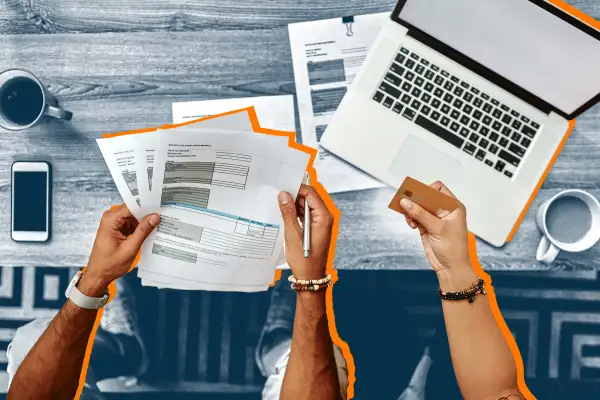5 Ways to Ditch Your Credit Card Debt for Good

Americans’ credit card balances have soared over the past few years, as higher prices and interest rates have pushed the average borrower’s debt to $6,380.
With more of us owing larger outstanding balances, worries about missing a debt payment have grown, too. Some 13% of Americans fear they’ll run into such trouble within the next three months — a share that steadily climbed for most of 2024.
If you’re among the half of Americans who aren’t paying off their full balance each month, switching to the other side can be challenging. But the following five strategies, all backed by financial planners and credit experts, will show you how to pay off credit card debt — and get to $0 owed.
1. Stop spending and pay more than the minimum
You can’t free yourself of credit card debt if you keep increasing how much you owe by using your cards, says credit expert Beverly Harzog, author of The Debt Escape Plan: How to Free Yourself From Credit Card Balances, Boost Your Credit Score, and Live Debt-Free. Instead of charging expenses, pay with cash or a debit card. This switch will also help you better understand exactly where your income is going so you can spot places to cut back on unnecessary spending and, hopefully, free up some additional funds to repay your debts.
Once you stop adding to your balance, one of the best ways to pay off credit card debt is fairly simple: You’ll reduce your debt quicker if you pay more than the monthly minimum amount required by your credit card company. That’s because the minimum payment equals only a small fraction of your total outstanding balance, leaving the remaining debt to accrue costly interest on top of your original charges.
So bumping up your payment will help you eliminate your balance faster and save on interest costs. For instance, if you make a monthly minimum payment of $285 on a credit card with a $10,000 outstanding balance and an interest rate of 22% — the average current APR — it would take you nearly five years and $6,171 in interest to pay off. Increase that monthly repayment by $50 and you’ll be debt free 13 months earlier and save $1,558 in interest charges.
2. Use the snowball or avalanche method
Rather than applying a little extra to each of your monthly minimum payments, experts recommend you focus on eliminating one debt at a time. Doing so can help you stay motivated, feel a stronger sense of progress, and remain on track during the sometimes lengthy debt clearance process, Harzog says.
There are two common approaches to deciding which debt takes top priority, the snowball method and the avalanche method. Both require that you funnel any extra money toward a single card’s debt while still making the required monthly minimum payment on all other cards. But one works better for those driven by small wins while the other helps those fixated on cost savings.
With the snowball method, you’ll pay off the credit card with the lowest outstanding balance first. Once that debt is cleared, you move on to the card with the next smallest balance, repeating this pattern until you clear out all your balances.
“Once you have gotten into a hole with multiple credit cards, the debt can seem insurmountable unless you can see progress,” says certified financial planner Crystal McKeon, chief compliance officer for TSA Wealth Management in Houston. “From a psychological perspective, the debt snowball method can help you see your progress and keep with it until you have reached your debt-free goal. A small victory can motivate you to continue.”
Paying off the smaller balances first can also help improve your credit score quicker, as scoring models like FICO and VantageScore prefer you have fewer credit cards with balances, says credit expert John Ulzheimer, formerly of FICO and Equifax.
The better financial move, however, is the avalanche method, according to McKeon. Because this strategy focuses on attacking the credit card debt that’s racking up the most interest, you’ll pay less in financing costs than with the snowball method. Once you’ve cleared your most expensive debt, you move on to the card charging the second-highest APR, continuing until you’re debt free.
Alternatively, you can create your own prioritization system or combine methods. Harzog recommends one such hybrid, the blizzard method, which calls for paying off the smallest balance first for that initial achievement buzz before tackling the card charging the costliest interest.
“Do what works for you,” says Rod Griffin, senior director of public education and advocacy for credit bureau Experian. “Whatever method or combination of methods is going to keep you motivated to pay off your debt and not feel defeated, that is the right one for you.”
3. Apply for a balance transfer card
Moving your outstanding credit card balances to a new card offering a lower interest rate is the cheapest way to get out of debt, Harzog says.
Many credit card companies offer 0% introductory financing perks for new balance transfer card users, meaning you can shift your existing debt to a new card, and, for a limited time, usually between 12 and 21 months, no new interest charges accrue. In other words: If you clear your balance during this financing pause, you won’t have to worry about additional interest costs increasing your debt load.
Your debt typically needs to move onto the new card within a set period, like the first 60 days, to take advantage of the introductory financing offer. Credit card companies usually charge a fee of between 3% and 5% of the transferred amount to complete this transaction for you, adding the sum to your outstanding balance. To avoid this expense, check credit union offerings — see Money’s top choices for a no-fee balance transfer card.
Because this kind of card usually requires a credit score of 660 or higher and the balance you can carry forward is capped by the card’s credit limit, this strategy tends to work best for those who have good credit and smaller debt loads. You’ll also need to be sure you can pay off the balance in full before the 0% promotional rate ends as these cards can charge standard APRs as high as 30%. If you don’t, the move could wind up increasing your interest costs rather than reducing them.
The other potential pitfall of using a balance transfer card? It makes it easy to spend again, pushing you further into debt. “Resist the temptation to use the cards you’ve just paid off or make new purchases on the balance transfer card,” Griffin says“You can’t offset your debt if you’re still spending.”.
4. Simplify debts with a consolidation loan
Consolidating all your various credit card debts under a single new loan can help you more effectively manage your bills by providing a lower interest rate, smaller required monthly payment or fixed repayment schedule.
“Converting the debt to an installment loan takes away the flexibility to spend more with a credit card or slip off your plan and make just the minimum payment due one month,” Griffin says. “It helps you stick to a repayment time frame more effectively.”
With a debt consolidation loan, you’ll borrow an amount equal to your outstanding debt and then use those funds to pay off your credit cards. If you choose a loan with a fixed interest rate, you’ll pay the same amount each month, making it easier to budget. These loans typically last between two and seven years and charge lower interest rates than credit cards do. You could also see a credit score improvement as installment debt, like loans, is looked upon more favorably by lenders than revolving debt, Ulzheimer says.
To get the most favorable loan repayment terms and lowest interest rates, you’ll need a strong credit score. While the average 24-month personal loan charges 12.33% interest, according to the Federal Reserve, those with credit scores of 720 or higher may be able to nab rates as low as 7%. Borrowers with low scores could face rates above 20% — or more than their credit cards charge. The Consumer Financial Protection Bureau recommends checking that any low rate offered on your loan isn’t a teaser rate that will jump up after a brief period.
Homeowners with at least 20% equity in their property can also tap into their home’s value to help them repay credit card debt through a home equity loan. Because you’re using your home as collateral, these products typically have a lower interest rate than what debt consolidation loans and credit cards charge. They’re best suited for borrowers with higher debt loads, as most lenders mandate that you borrow a large amount, typically at least $10,000, to be approved.
Note that you will typically pay some kind of origination fee, closing cost or other processing fee equal to between 2% and 5% of the total borrowed amount. Finally, because your home acts as collateral, failing to make timely repayments risks foreclosure.
5. Get expert help
If you’re struggling to make the minimum credit card payments required each month and can’t qualify for a balance transfer card or loan, it’s probably time to seek outside help.
Those just starting to feel the pinch, should contact their card issuer to ask for a lower interest rate or promotional offer, says Melissa Caro, a certified financial planner with FBN Securities in New York City.
For larger repayment concerns, speak with your credit card’s hardship department, Harzog advises. “Explain the situation that is causing the issue, like medical debt, divorce or job loss, how it has impacted you, and your plan for how to get your finances back on track,” she says You can ask for a lower interest rate or minimum payment, waived fees or some other plan to help you manage your debt, though you’ll see the most success if you do this before you miss any payments.
If you’re behind on payments or have delinquent debt, consider working with a credit counseling service that will go over your finances and help you figure out how to better deal with your debt, Griffin says. These organizations, which can be found through the Financial Counseling Association of America or the National Foundation for Credit Counseling websites, usually provide a free initial session but charge a monthly fee when you enroll in a debt management plan.
Under a debt management plan, you’ll make a monthly payment to the counseling organization, which will then distribute that money to your creditors and negotiate with them on your behalf to avoid fees or get better repayment terms. But they won’t be able to reduce your total debt owed.
Finally, you can try getting credit card debt relief by working with a company that will negotiate with your creditors to get them to accept a settlement that’s less than what you owe. One study found that a typical consumer working with a debt relief company had about half their accounts successfully settled, with a typical debt write-down of about 30% after accounting for fees.
But this strategy has downsides: Because creditors are unlikely to accept a deal until after you’ve fallen behind on your payments, the process usually requires you to stop paying (or continue not paying) your bills. That, in turn, damages your credit score. There’s also no guarantee that the companies will successfully negotiate with your lenders. In fact, businesses that guarantee to lower your debt by a certain amount are a red flag.
To avoid scam operations, look for companies accredited by the American Association of Debt Resolution and steer clear of anyone charging upfront fees before they’ve successfully negotiated a settlement as this is illegal.
More from Money:
5 Things People Get Wrong About Debt Relief
Struggling With Debt? Here Are 4 Options to Get Things Under Control

